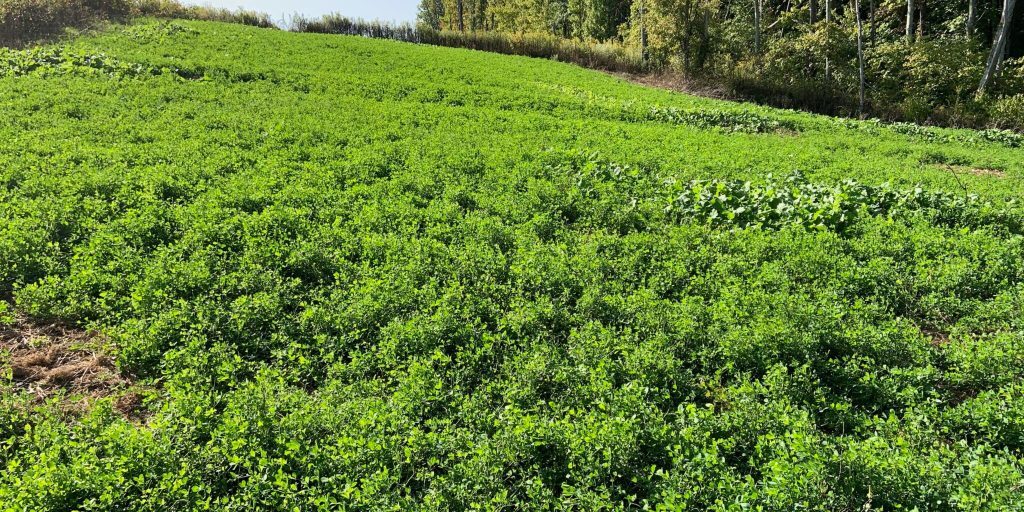By: Brian Scott Halbleib
While sitting in the towering, shadowy, spruce trees of the Black Hills of South Dakota in a tree stand many years ago, I had a front row seat to the attractiveness and drawing power of alfalfa when it comes to deer. Waves of deer, numbers approaching three digits, passed by my stand, en route to those lush, glowing green, alfalfa fields in the valley below as they left the security of their bedrooms, high up on the murky, evergreen choked hillsides. Even today, it’s hard for me to explain to my Eastern Woodland friends the experience of seeing years worth of deer sightings in a single sit. I was just getting into habitat management back then but already had a decade or so of experience with deer behavior and feeding habits under my belt.
It was not until years later when I was managing a forty-acre farm that I owned in northeast Ohio, that I finally planted an alfalfa field of my own. Up until then, I had planted some clover-alfalfa mixes but never an entire field dedicated to Medicago sativa. At that point, I had space, and the soil type, to give it a go. But alfalfa can be a challenge. It doesn’t like low PH, wet feet, or shade. Weed control is also essential and can complicate things for the average food plotter. All of these things kept me from adding it to my properties over the years until I got a little nudge from one of my habitat management mentors, Wally White, and a new technology called Round-Up Ready.

I know what some of you are thinking already. You are concerned about the use of herbicides and have heard horror stories about many of them, especially the infamous Round-Up variety from Monsanto. I will not go into that debate in this article but I will share my personal experiences with the herbicide based on years of using it sparingly on my properties. If you have a zero herbicide tolerance policy, I totally respect that and I would encourage you to seek information elsewhere if you are looking to establish alfalfa without the use of them. For those of you still with me, let us do a quick and dirty refresher of Round-Up, or what us habitat managers refer to as Gly (glyphosate).
Contrary to popular urban legends, glyphosate has been around for nearly fifty years. Many, many, many acres have been planted, sprayed, and harvested over and over again since then. That is a fairly decent amount of time for a lot of independent research to be conducted. Glyphosate works on a molecular level in the plant, NOT IN THE SOIL. Basically, that means the plant has to be actively growing for glyphosate to work as a herbicide. Unlike pre-emergent herbicides that are added to the soil to prevent the germination of plant growth. Spraying glyphosate on bare dirt will not stop the seed in the seed bank from germinating.
Fifty years of research and analysis aside, I had personally used glyphosate sparingly as needed for seven growing seasons on that forty acres. I have planted glyphosate-resistant (also known as GMO) corn, soybeans and alfalfa over that period. I have followed Round-Up Ready corn and soybean crops with fall grains (rye, wheat and oats), brassicas (turnips, radish and rapeseed) and clover. Most of these fields were sprayed twice after planting according to the herbicide label. Read that again. ACCORDING TO THE HERBICIDE LABEL. Now, I can tell you that every one of those fall plots or cover crops that I planted were lush and healthy. This can also be said for fields that were left fallow and naturally regenerated themselves from the seed stored in the seed bank the following spring. I am not a scientist but after observing that for seven growing seasons, one might conclude that the soil remained healthy and capable of producing vegetation. So with all that being said, let’s get back to adding alfalfa to your habitat plans.
One of the benefits of glyphosate-resistant alfalfa is the ability to plant it just about any time of the growing season (with proper moisture available). I had success with my first three alfalfa plots on that forty acres using conventional tilling and broadcasting in the spring. In a perfect scenario, we often like to establish spring and summer crops the spring following a fall application of glyphosate, whether that be from an annual Round-Up Ready crop or a new field prepared for spring planting. In January of 2020, I joined a new deer hunting lease in Ohio and obviously did not have time to prepare anything the previous fall. The property owner allowed us to plant some unused corners of open ground that were outside of the cattle pastures. The spot I decided to plant alfalfa was around three-quarters of an acre, received full sun, and was gently sloping where a gas line right of way met a pasture. A soil test showed a PH of 6.2 and decent overall ratings in the medium to optimum range. A perfect candidate for alfalfa with a few tweaks based on the soil test.

I got that field sprayed somewhere around the end of May, beginning of June and waited a good two weeks before seeding on June 13th. Alfalfa seed is tiny and makes getting good seed to soil contact easy even on a late sprayed field like this one. The vegetation had gotten about six to eight inches tall before being terminated. That is about as tall as I would be comfortable letting it get before terminating. Once a field gets too tall, the herbicide cannot reach all the growing plants and getting an even kill is difficult. As always with no-till broadcasting of seed, the closer you can finish before a rain event the better. That is usually never an issue during spring time/early summer in the Midwest.
Once established, the second round of herbicide will need to be applied about four to six weeks later, depending on the veracity of the broadleaf and grass competition growth. Alfalfa fixes its own nitrogen so none is usually needed unless your soil test advises otherwise but it is a good idea to fertilize (phosphate and potash) the alfalfa right before a rain event once that second round of glyphosate has terminated the competition.
That is the beauty of glyphosate-resistant alfalfa, a guy or gal could have a great stand prepped, planted, and maintained in three to four trips to their farm or lease with minimal equipment. Add the benefit of 16-26% highly digestible protein, drought resistance, thanks to a 5-foot tap root, and attractiveness from spring up to the rut, how could alfalfa not be a part of your management plans? Now I will warn you to be prepared for the sticker shock of Round-Up Ready alfalfa. And at nearly $10 per pound and planting rates around 15 to 20 pounds per acre, this can add up quickly. However, a properly cared for alfalfa plot can easily last 7 to 10 years with minimal maintenance thanks to its glyphosate resistance. The investment makes good sense with that kind of math. So I encourage you to give it a shot and soon you will see your deer crowding your alfalfa fields like their cousins out west.

You can purchase GLYPHOSATE <– here
Habitat PODCASTS & GEAR: http://bit.ly/HABITATGEAR
Leave us a great review here: https://apple.co/2uhoqOO

